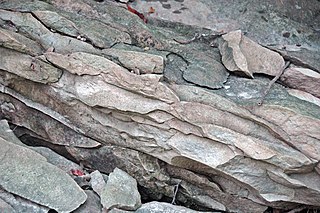
The Hinton Formation is a geologic formation in West Virginia. It preserves fossils dating back to the Carboniferous period. It is mainly made up of limestone, sandstone, and shale.
The Williamsport Sandstone is a sandstone geologic formation in West Virginia, Virginia, Pennsylvania, and Maryland. the formation includes the Cedar Creek Limestone member. Near Cumberland, Maryland it includes the Cedar Creek Limestone member. It preserves fossils dating back to the Silurian period.
The Dundee Limestone is a geologic formation in Michigan, Ohio and Ontario. It preserves fossils dating back to the Devonian period.

The Maxville Limestone is a geologic formation in Ohio. It preserves fossils dating back to the Carboniferous period.

The Harrodsburg Limestone is a geologic formation, a member of the Sanders Group of Indiana Limestone, of Mississippian age. It was named for Harrodsburg in southern Monroe County, Indiana by T. C. Hopkins and C. E. Siebenthal. It is made up primarily of calcarenite and calcirudite. It also may include some beds of dolomite and shale.

The Everton Formation is a geologic formation in northern Arkansas that dates to the middle Ordovician Period. Unconformities separate this formation from the underlying Powell Formation and the overlying St. Peter Sandstone Formation. Named for the town of Everton in Boone County, Arkansas in 1907, the Everton Formation is composed primarily of dolomite, limestone, and sandstone.

The Burlington Limestone is a geologic formation in Missouri, Iowa and the Midwest region. It preserves fossils dating back to the Mississippian subperiod.
The Urswick Limestone is a geologic formation in England. It preserves fossils dating back to the Carboniferous period.
The Milldale Limestone is a geologic formation in England. It preserves fossils dating back to the Carboniferous period.
The Monsal Dale Limestones is a geologic formation in England. It preserves fossils dating back to the Carboniferous period.
The Chee Tor Limestone is a geologic formation in England. It preserves fossils dating back to the Carboniferous period.

The Clifton Down Limestone is a geologic formation in England. It preserves fossils dating back to the Carboniferous period.
The Ashfell Limestone is a geologic formation in England. It preserves fossils dating back to the Carboniferous period.
The Bee Low Limestones is a geologic formation in England. It preserves fossils dating back to the Carboniferous period.

The Lulworth Formation is a geologic formation in England. It dates from the late Tithonian to the mid Berriasian. It is a subunit of the Purbeck Group. In Dorset, it consists of three members, which are in ascending order, the Mupe Member, the Ridgway Member, and the Warbarrow Tout Member. The Mupe Member is typically 11 to 16 m thick and largely consists of marls and micrites with interbeds of calcareous mudstone. The Ridgeway Member is about 3 to 7 m thick and consists of in its western portion carbonaceous muds, marls and micrites, in the east the muds are replaced by micritic limestone. The Warbarrow Tout Member is 17 to 39 m thick and consists of limestone at the base and micrite and mudstone for the rest of the sequence, this member is the primary source of the vertebrate fossils within the formation. Elsewhere the unit is undifferentiated.
The Torquay Limestone is a geologic formation in England. It preserves fossils dating back to the Devonian period.
The Keisley Limestone is a geologic formation in England. It preserves fossils dating back to the Late Ordovician period.
The Creechbarrow Limestone is a geologic formation in England. It preserves fossils dating back to the Paleogene period.
The Great Scar Limestone Group is a lithostratigraphical term referring to a succession of generally fossiliferous rock strata which occur in the Pennines in northern England and in the Isle of Man within the Tournaisian and Visean stages of the Carboniferous Period.

The Solent Group is a geological group in the Hampshire Basin of southern England. It preserves fossils ranging in age from Priabonian to Rupelian. The group is subdivided into three formations, the Headon Hill Formation, the Bembridge Limestone Formation and the Bouldnor Formation.








